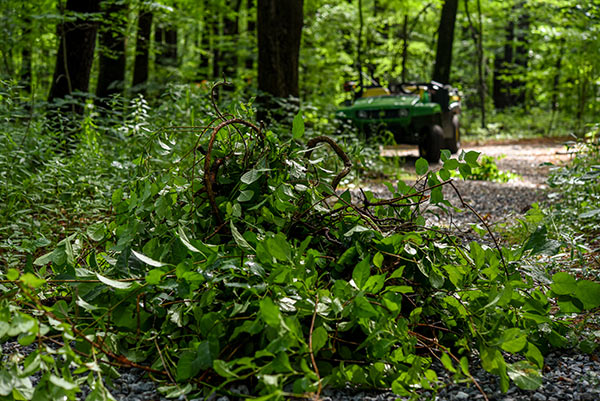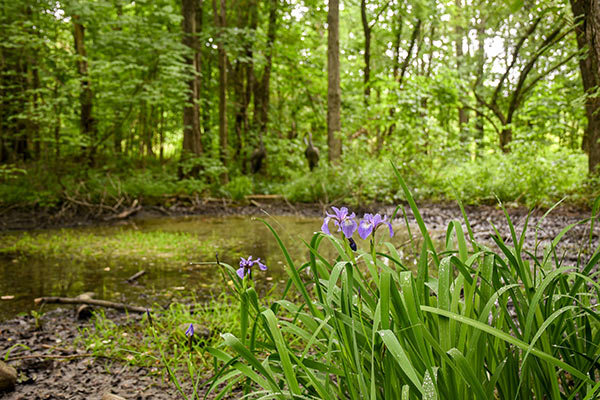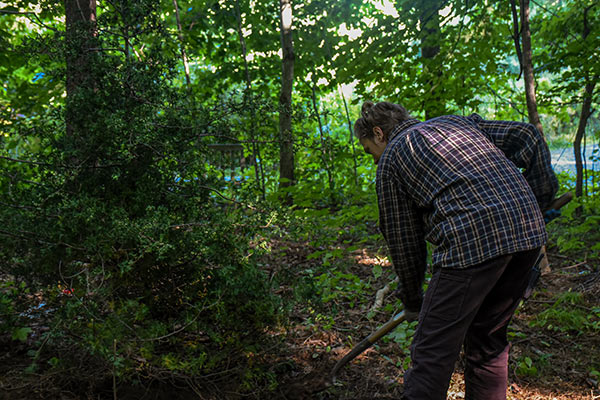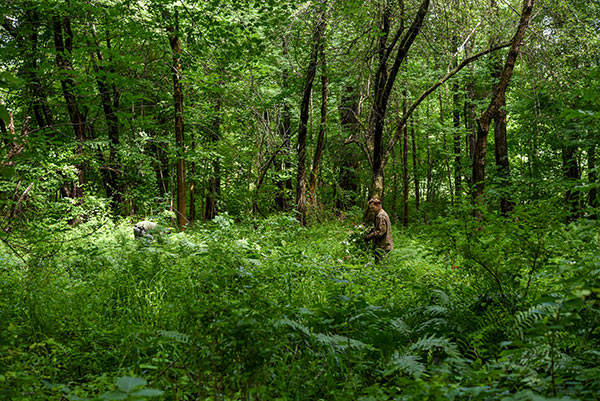By Georgia Albanese, Landscape Gardener
April 2025
Envision yourself on a stroll through the naturalistic gardens at NEBG. You’re surrounded by tall trees glimmering in sunlight, and you’re enjoying the sounds of birds chirping and plants rustling. You come across a plot of forested wetland, containing a vernal pool, directly between the Wildlife Pond and the Shade Garden, and think, “What is this space?” You have reached the Wildlife Garden.
The Wildlife Garden is an area that tends to fly under the radar when compared to some of the more formal, manicured gardens of NEBG—and it does so with reason. This garden, as the name states, is designed to support our local wildlife species and serves as an exemplary project of ecological restoration.
During the days the Carter Farm operated here at Tower Hill, this space served as an onsite dump. Metal equipment, glassware, and more were discarded here and forgotten. Due to the disturbance and subsequent neglect, the area overgrew with invasive plants intensely. Over the course of the Garden’s existence, staff and volunteers have sporadically worked at removing the invasive plants and planting natives, but the Wildlife Garden didn’t receive the direct restoration attention it needed and deserved until 2023 when I first began working at the Garden as part of the land stewardship team. Since then, this garden has transformed dramatically, and I have learned much along the way.
Walking into the Wildlife Garden in the spring of 2023 for the first time, I saw a sea of multiflora rose (Rosa multiflora) and Asiatic bittersweet (Celastrus orbiculatus) blanketing the forest floor and suffocating trees and shrubs; it was overwhelming. Folks who work in environmental conservation and restoration tend to feel physical and emotional burn-out when dealing with invasives due to their aggressive nature and how difficult it is to control them. I had to remind myself that restoration ecology is a multi-year process, and to get rid of well-established invasive plants takes numerous seasons of removal.
That spring and early summer, I cut into the invasive plants little by little by using an electric brush-cutter to slice the plants at their base. During this first removal process, I dragged out all cut invasives from the space and discarded them appropriately. Removing cut plants from a site is most recommended during this time, before the invasives have had a chance to flower, to avoid further spread. This also allowed me to see the space more clearly, understand the landscape, and envision where new plants could be placed.
In choosing plants to be added into this opened-up plot, I focused most on what would best support the Garden’s local wildlife and pollinators. This included shrubs that would serve as strong thicket habitat such as mountain holly (Ilex mucronata) and sweet pepperbush (Clethra alnifolia), or food sources such as black chokeberry (Aronia melanocarpa) and blue huckleberry (Gaylussacia frondosa). Another focus in plant design was choosing herbaceous plants that provide significant pollinator benefits, such as red cardinal flower (Lobelia cardinalis) and swamp milkweed (Asclepias incarnata). Throughout the 2023 and 2024 growing seasons, I added 65 native species of shrubs, trees, or herbaceous plants, including a seed mix that was spread in the upland region of the garden in early spring. The native seed mix was combined with sand to give it the weight it needs to reach the forest floor and spread evenly. All in all, this came to a total of 847 new individual plants added to the Wildlife Garden. I have been able to witness firsthand the increase in diversity of birds, bees, and other creatures in this space due to the installation of more beneficial plants, and management of invasive plants.

A pile of Asiatic bittersweet (Celastrus orbiculatus) on a path after being removed from the Wildlife Garden.
When it comes to transforming this area into a space where native plants and animals thrive, and are not out competed by invasive plants, there’s still a long way to go. Despite the fact that I have executed numerous cuts of multiflora rose and Asiatic bittersweet, some days resprout appears to be inevitable. Chemical treatment will eventually be necessary during a future fall season, when an herbicide can most effectively reduce the invasive growth and weaken those aggressive plants. While we make conscious attempts to avoid pesticide intervention in fragile environments, some severe cases can be exceptions to allow our native plants to thrive and improve the health of our ecosystems in the long term. Still, our ongoing efforts here demonstrate that ecological restoration takes time, up to many years, for a piece of forest to return to its most natural, beneficial state. That’s why it is up to us as conservationists, homeowners, or gardeners to give a hand to the land when our native species are being outcompeted. This spring and summer, I hope visitors will explore the Wildlife Garden, discover the changes we’re bringing about in this overlooked space, and feel inspired to take initiative on their land, to intervene and restore when the environment asks us to do so.
About the Author
Georgia Albanese was a Landscape Gardener at New England Botanic Garden at Tower Hill from 2023 to 2025. She was mainly responsible for regular groundskeeping of the property as well as executing various conservation projects within the Garden’s natural spaces. Georgia holds a B.S. of Environmental Conservation and Sustainability from the University of New Hampshire; her professional interests include restoration ecology, pollinator conservation, and sustainable systems.



